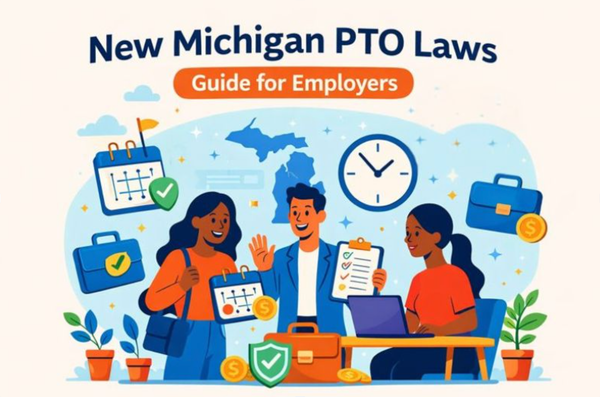How to calculate PTO: Part-time employees
Learn how to calculate Paid Time Off (PTO) for part-time employees with clear formulas, pro-rata examples, and compliance tips. Create a fair, easy-to-manage PTO policy.

Calculating Paid Time Off (PTO) for part-time employees can be a challenging exercise because it’s not as easy as simply reducing benefits offered to full-time employees.
For this reason, we here at BuddiesHR compiled an easy-to-use guide for employers that will help you navigate this employee minefield.
Let’s begin by defining what a part-time employee is and how this is foundational to defining part-time PTO benefits.
Create a transparent, easy to implement leave request process for your whole company.

Who qualifies as a part-time employee
The generally accepted answer to this question is: Anyone who works less than 30 hours a week. While this is a good guideline, the Fair Labor Standards Act does not clearly define who a part-time employee is, and the employer's workplace policy is more likely to provide the answer.
The employer’s policy will also dictate what benefits a part-time employee enjoys. This can include vacation leave, sick leave, maternity/paternity leave, and other paid time off work.
For help with the definition of a part-time employee, there are agencies that clearly define categories of work, such as the IRS. Here is a summary:
- The Internal Revenue Service (IRS) defines a full-time employee as someone employed on average at least 30 hours of service per week, or 130 hours of service per month. Therefore, anyone who consistently works less time, is considered as part-time.
- A report compiled by the Bureau of Labor Statistics defines part-time workers as anyone who usually works fewer than 35 hours a week.
- The Department of Labor leaves it up to the employer to determine what a part-time employee is.
- To qualify for benefits under the Affordable Care Act, an employee must work under 30 hours a week.
When establishing a PTO policy for part-time workers, take these basic stipulations into account, as well as any:
- Federal law, or
- Local law (State law) that governs employee relations.
Why you should establish a part-time PTO policy
As an employer, it is essential to clearly define the policies pertaining to your part-time employees. This is especially true when the industry mostly uses part-time workers, like the hospitality, retail environment, or general office workers.
An employee handbook increases transparency in employment and improves employee satisfaction because each staff member knows what benefits they have. More importantly, it helps employers to consistently apply fair PTO practices, which is key for a good employer-employee relationship.
At a basic level, offering paid time off to employees who only work a low number of hours a week is seen as a perk. This should be put forward as such, and regulated, so that you (as the employer) can have a healthy benefit package, without being disadvantaged.
How to calculate PTO for part-time employees
Since there are no hard and fast rules governing this topic, mostly employers choose a pro rata system of allocating paid time off for part-time employees. What follows are guidelines on how you can go about calculating paid leave for each leave category.
General guideline: The pro rata system
A common system is to pro rata pay vacation time for part-time workers relative to what full-time employees get. Let’s look at an example where a full-time worker receives benefits based on working +40 hours per week.
Formula:
(Hours worked per week ÷ Full-time hours) × Full-time PTO entitlement
Example:
A full-time employee at a water treatment company gets 80 hours of PTO a year, and the company consistently employs part-time workers to count inventory, and they work 20 hours a week, then:
(20 ÷ 40) × 80 = 40 hours of PTO/year
In this scenario, the part-time worker only works half the hours and therefore gets half the amount of vacation days.
Calculating PTO for different leave categories
This formula can now be applied to the different leave categories, namely vacation leave, sick leave, paid holidays, personal days, bereavement leave, parental leave, and jury duty leave.
1. Vacation leave
Vacation leave here in the U.S. is defined as the amount of time an employee can take off work, usually with pay, in order to relax and rejuvenate. [1]
Should you, as an employer, wish to offer vacation leave to part-time workers, you can calculate it using the following example:
The formula used to calculate this (based on 25 hours p/week of work):
(25 ÷ 40) × 120 = 75 hours vacation/year
With this example, you can see why simply reducing full time vacation leave by half and allocating it to part-time employees is not the most accurate way of doing things. By applying this logic, the part-time employee gets 7.5 instead of 9 vacation days.
You also have the option of calculating vacation time on an accrual basis, where leave is accrued based on the number of hours worked. E.g., 0.0577 hours of vacation for every hour worked (calculated using a full-time employee).
Vacation leave: Accrual basis calculation
So, where does the 0.0577 hours come from? Working on the same assumption as the above calculation, where an employee receives 120 hours of PTO, then:
- Total annual vacation time for a full-time employee = 120 hours/year
- Total hours worked per year by full-time employee = 40 × 52 = 2,080 hours/year
- Hourly vacation accrual rate = 120 ÷ 2,080 = 0.0577
So, for each hour worked, the employee earns 0.0577 hours of vacation.

2. Sick leave
Sick leave is paid, or unpaid leave (as per the Family and Medical Leave Act) granted to an employee to recover from short-term illness, attend medical appointments, or take care of a sick family member. A common rule for sick leave is: 1 hour paid leave per 30 hours worked.[2]
In the state of California, minimum sick leave has been mandated for all employees (including part-time workers), under a paid leave ordinance. It is advisable that employers check their state mandated laws around paid sick leave before finalizing a paid sick time policy.
Should you offer paid sick leave, you can calculate it as follows:
- A part-time employee works 15 hours/week for 50 weeks = 750 hours/year
- 750 ÷ 30 = 25 hours of sick leave/year (roughly 3 days a year).
3. Paid holidays
Paid holidays are federal, state, or employer designated days off (e.g., independence day, or thanksgiving). These days, employees are paid without having to work. However, employers are not obligated to pay workers for these days. But if you do, there are two options for working out how to pay your part-time employees.
Option A: Pro-rata holiday pay
If a company normally gives 8 hours of paid holiday leave to a full-timer, and a part-time employee works 20 hours a week, then:
- (20 ÷ 40) × 8 = 4 hours holiday pay
In this scenario, the part-time worker will get paid for half the day, and the other half will be unpaid.
Option B: Pay only if scheduled to work
Only pay for a holiday if the employee is scheduled to work on that day. This keeps the payment for holidays fair and equitable amongst all types of employees.
4. Parental leave
This is leave provided for the birth, adoption, or foster care placement of a child. This type of leave is dependent on the employer or the state. The Family and Medical Care Act (FMLA) dictates what employers should offer.
A simple way of allocating paid parental leave is as follows:
- Full-time paid leave = 12 weeks at 40 hours/week
- Part-time leave = 12 weeks at 20 hours/week pay
The FMLA does not guarantee paid parental leave for part-time employees eligible for this benefit. An employee must meet the following criteria to get work-protected unpaid parental leave:
- An employee must have worked for at least 12 months before the parental leave commences.
- The employee must have worked at least 1,250 hours during the 12 months to qualify for the benefit.
4. Personal days off
Personal days off are days employees can use at their own discretion to attend to personal family matters, because they need a break, or for religious observances.
Most employers who offer this benefit allocate a fixed number of days per annum. For example, a full-time worker is allocated 16 hours a year, and a part-time worker is allocated a pro-rata amount.
Example:
A waiter works a total of 24 hours a week at a local restaurant and wants to know if they can take personal time off. The calculation could look like this:
- (24 ÷ 40) × 16 = 9.6 hours
The calculation is done on the same pro-basis as the other calculations we have been discussing.
How to keep track of paid time off
Just when you thought you’d resolved your biggest leave problems by sorting out a PTO policy, working out how much you’re willing to pay everyone, and communicating the policy, it suddenly dawns on you that you have to keep track of everything - problem!
You could try to do this manually by creating a PTO spreadsheet, and if you’re a really small company, that might work well. But if you have a number of employees and don’t want to spend your life updating a spreadsheet, you need another solution.
That solution comes in the form of a Vacation Tracker that automatically helps you keep track of vacation balances for all your employees. A vacation tracker will help you accurately track vacation balances and vacation requests, streamlining the entire process for you. Here’s what you can expect:
- Manager approval in minutes: A request for PTO is generated by the employee and automatically forwarded for approval to the relevant manager (this can be set up on the vacation tracker).
- Instant visibility: Both the employer and employee can see who is off and when they will return.
- Automated leave balances: Leave balances are calculated by the app, as per the guidelines you load on the system.
- Centralized leave history: Reports that provide you with a comprehensive record of leave history.
The best part about this solution is that it integrates seamlessly with Slack, and is extremely affordable - we’re talking less than $1 per employee/pm.
Get started with the best vacation tracker available
Conclusion
Calculating Paid Time Off (PTO) can be tricky, and for this reason, employers need to apply best practices to this situation. By choosing either a pro-rata or accrual method of calculating leave for part-time employees, you can avoid the over-simplified system of merely reducing full-time leave allocation by half.
To streamline the entire process from the start, it’s advisable to invest in a vacation tracker app that will not only give your visibility over all leave requests and keep balances up-to-date, but also provide you with historical information. Armed with your PTO policy and vacation tracker, you’ll be well on your way to implementing sustainable, affordable, and equitable employee practices.

References:




